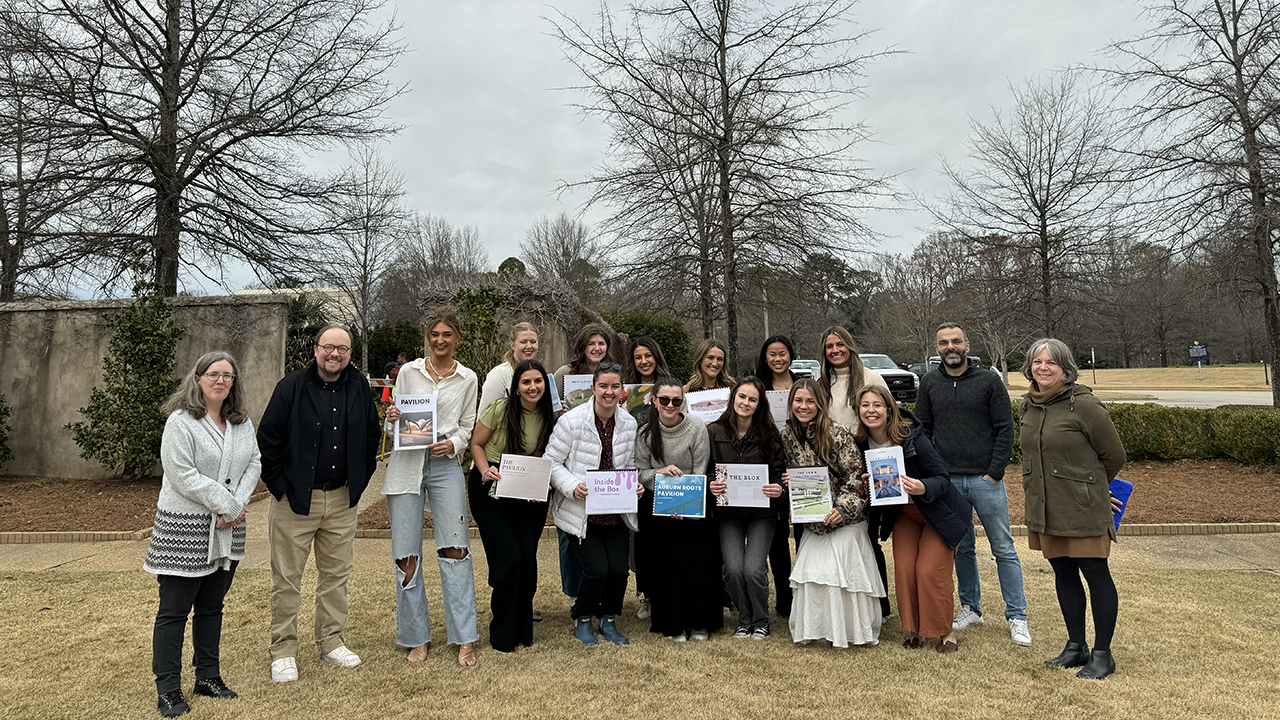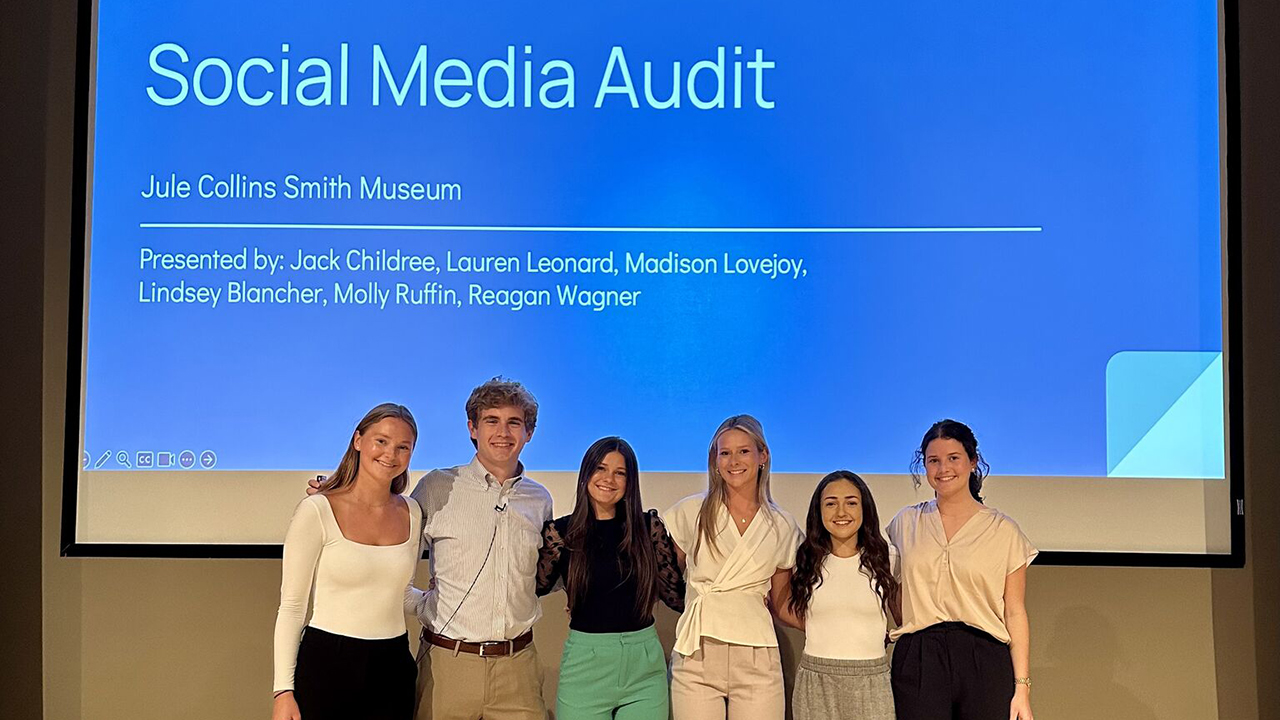content body
Then-student Emily Hatcher's design for The Jule's outdoor pavilion captured on Adobe Aero.
On a blustery spring afternoon, interior design students gathered outside of The Jule Collins Smith Museum of Fine Art at Auburn University, armed with tablets and phones loaded with Adobe Aero, an augmented reality authoring and publishing tool. Shouting over bursts of wind, students presented their ideas for an outdoor pavilion space to facilitate outdoor teaching and learning at The Jule, while museum staff wandered the grassy space, exploring true-to-scale digital models of each design through their screens.
Clean lines and elegant arcs glided overhead, mirroring The Jule’s building structure and style. Other digital pavilions incorporated grassy walls and colorful play areas, nodding to the museum’s sweeping grounds and its K-12 educational programs. Some featured round tables for outdoor art activities and ampitheatre seating for potential outdoor presentations or film screenings. The ideas were endless.
Tasked with creating structures to engage all age groups and enhance the museum’s spatial experience, the upperclassmen of Georges Fares’ interior design course examined The Jule’s Susan Phillips Gardens, imagining pavilions that could be used by all for learning, community engagement and interaction; incorporating elements that connect people with nature; and ensuring both ease of maintenance and distinctive design.
As Meredith Hand, one of Fares’ students, put it: “It was a great experience before going into the real world as a designer.”

Interior design students present their designs to The Jule's staff.
A Unique Student Experience
Now alumni, many of Fares’ students cited the benefit of the hands-on aspect of the project to their careers. “Working closely with the museum allowed us to apply theoretical knowledge to practical situations, fostering a deeper understanding of the design process and its impact on various stakeholders,” recent graduate Madie Camp said. She went on to mention how the project had helped to further refine her skills as a future designer.
“This practical experience mirrors the projects they are likely to encounter in the professional world,” Professor Fares said. “By integrating technologies such as digital rendering, 3D printing and augmented reality into the project, students gained practical exposure to cutting-edge design tools” that are highly sought after in today’s design industry, going on to note that experience with such technologies gives Auburn’s interior design graduates a competitive edge in the job market.
To support the university’s mission, The Jule avails itself as a resource for Auburn’s faculty and students, regardless of their chosen field of study. “We always welcome faculty to develop projects with us based around art on view or research objects for temporary display in the study room,” said Chris Molinski, The Jule’s Janet L. Nolan Director of Curatorial and Educational Affairs. “But the entirety of the museum, including our grounds and the building itself, can be leveraged for study and experimentation by faculty in many fields.”
Molinski added that the museum is situated near one of the oldest, continuous soil fertility studies in the South and a five-year study to test a soil amendment for wildflowers that benefit pollinators, further exemplifying the versatility The Jule provides as an academic resource to craft the unique student experience Auburn is known for.

Honors college students studying marketing at the Harbert College of Business present the results of their social media audit to The Jule Museum staff.
Faculty Engagement Beyond Traditional Fields
While The Jule frequently invites the traditional fields of art and art history to take advantage of its object collection, museum staff also look to work across disciplines with professors outside of arts and humanities fields on projects that can advance their courses and their students’ experiences. Emory Serviss, lecturer in the Department of Marketing at the Harbert College of Business, found a partner in The Jule when his students needed a real-world project.
Honors College students in Serviss’ marketing course took on The Jule as a client for a social media audit, examining the museum’s digital footprint and engagement on its various social platforms. The students presented their findings to museum staff, providing targeted recommendations for each profile and the museum’s overall digital communication strategy.
“This partnership allowed my honors students to apply digital marketing concepts in a real-world setting, enhancing their understanding of digital marketing strategies and analytics,” Serviss said. Just like their interior design counterparts, The Jule’s project with Serviss’ marketing class allowed them to gain hands-on experience that deepened their understanding of course materials, linked academic theory and practical application, and was relevant to their future careers beyond Auburn’s campus.
The project also "demonstrated the vital role that strategic digital marketing plays in the cultural sector,” Serviss said, higlighting the interdisciplinary potential between business fields and art museums. Fares echoed his colleague’s sentiments, saying the experience “underscored the strong connection between interior design education and art museums.”
The Jule as a Teaching Museum
Both interior design students and marketing students were encouraged to pursue leads and explore unconventional ideas. Fares noted the environment demonstrated to students how the principles of design and art can manifest in physical spaces and pointed out that The Jule itself serves as a reminder of Auburn’s commitment to the arts.
Serviss indicated the potential for crossover between business and museum work. “It was fascinating to explore how digital marketing principles could enhance the museum’s reach and engagement, thereby contributing to its mission and sustainability,” he said, pointing to the mutually beneficial relationship between the museum and the university. “Students gained unique insights and practical experience while The Jule received valuable digital marketing strategies to expand its audience.”
Research has shown the integration of art into curricula can measurably enhance academic and professional outcomes. After a study in JAMA from the American Medical Association revealed a significant improvement in first-year medical students’ observational skills upon engaging in a close-looking project observing paintings housed the Yale Center for British Art, the Yale School of Medicine integrated the course into its curriculum, requiring all students going through the program to engage in the measured close-looking at art. Over 26 medical schools around the world established similar programs, pointing to the unexpected benefit art museums can provide to non-humanities and non-arts fields.
“Careful observation, creativity, critical thinking – these are skills vital to Auburn students’ success no matter their major,” The Jule’s executive director Cindi Malinick said. “As an academic art museum, we believe in the value that art has to offer to all students in their future careers beyond Auburn.
“I have never had the opportunity to design an entire structure from start to finish,” said recent interior design alumna Lillian Friel, saying the experience was incredibly unique to Auburn. “I know that it is something that I will look back on fondly.”
Interested in working with The Jule for a class project? Contact Chris Molinski, Janet L. Nolan Director of Curatorial and Educational Affairs:
Get in touch!


